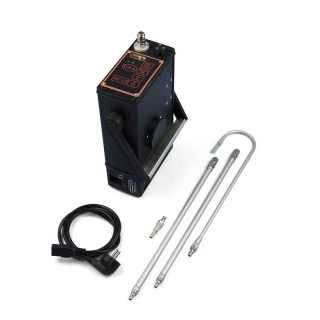Measurements by the GSA for pollutants
In the field of measurement technology, GSA is the point of contact for the use of measuring devices. For example, our measuring device SG12 is ideally suited for carrying out fibre measurements of asbestos fibers. Our partner, GSA Ratingen, offers the possibility of carrying out measurements on your behalf. For further information, please contact GSA Gesellschaft für Schadstoffanalytik.
The trained measurement technicians draw up a measurement plan and carry out the measurement on site. The samples are then analyzed and evaluated. The results can then be used to initiate further steps. For example, the existing occupational safety measures can be checked and then adjusted if necessary.

Work of a measurement technician for measuring of harmful substances
A measurement technician carries out measurements of harmful substances in various areas and evaluates the results. Various physical quantities such as current, pressure, temperature or substances are measured when measuring harmful substances. A good understanding of physics is therefore a good basis for this training. If the measurement technician works in energy technology, for example, their tasks include checking error and fault messages, carrying out measurements and evaluating the measurement results. Possible areas of application are power grid companies or machine and plant construction companies.
With our measuring devices, we offer support for measurement technicians in the environmental sector and in the field of occupational health and safety. Here, the occurrence and quantity of certain (harmful) substances are measured and evaluated.
The tasks of a measurement technician – measuring of harmful substances and more
The measurement technician has a wide range of tasks. It begins with positioning and aligning the measuring devices. This is followed by carrying out and checking the measurement. Once all the measured values have been recorded, the measuring construction is dismantled and finally the data obtained is analyzed and evaluated. Based on this, statements can be made about the presence of the substances, such as whether asbestos was detected and, if positive, in what quantity. Measures to improve occupational health and safety can then be discussed and planned.
The effectiveness of the strategies is then measured and evaluated at regular intervals.
Training and further education opportunities
Training to become a measurement technician usually involves an apprenticeship or even a degree in electrical engineering/measurement technology or similar. The duration of training is usually 3-5 years and can be shortened accordingly depending on qualifications. In addition to the technical theoretical competence, the practical side is also taught and various measurement techniques and procedures are practiced and demonstrated. Of course, there is also the option of doing further training while working and specializing in various measurement techniques. This can be combined with further training to become a safety officer, for example, thus combining the practical part of measurement with the theoretical part of occupational health and safety.
Sources:
[1] https://berufenet.arbeitsagentur.de/berufenet/faces/index;BERUFENETJSESSIONID=Az690hKAPSZkJp-unfjDNFiGBIDdg3XUajTGBrzvWKAxICJDFSRk!-148790827?path=null/kurzbeschreibung&dkz=5584
[2] https://www.berufslexikon.at/pdf/pdf3284-MesstechnikerIn?berufstyp=bhs
[3] http://www.bildungs-werkstatt.de/Ausbildung/Ausbildungszentren/Messtechnik_1231.html
[4] https://www.meisterschulen.de/fort-und-weiterbildungskurse/reinraum-service-messtechniker-in-ihk/reinraum-service-messtechniker-in-ihk

